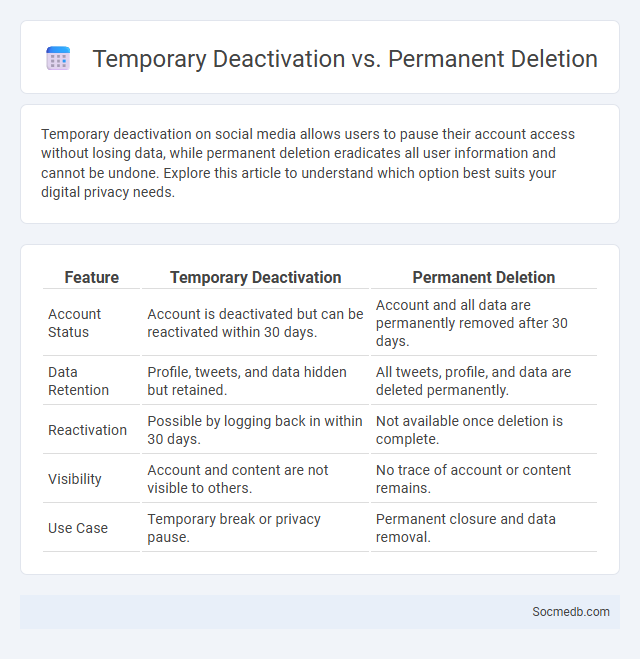
Photo illustration: Temporary Deactivation vs Permanent Deletion
Temporary deactivation on social media allows users to pause their account access without losing data, while permanent deletion eradicates all user information and cannot be undone. Explore this article to understand which option best suits your digital privacy needs.
Table of Comparison
| Feature | Temporary Deactivation | Permanent Deletion |
|---|---|---|
| Account Status | Account is deactivated but can be reactivated within 30 days. | Account and all data are permanently removed after 30 days. |
| Data Retention | Profile, tweets, and data hidden but retained. | All tweets, profile, and data are deleted permanently. |
| Reactivation | Possible by logging back in within 30 days. | Not available once deletion is complete. |
| Visibility | Account and content are not visible to others. | No trace of account or content remains. |
| Use Case | Temporary break or privacy pause. | Permanent closure and data removal. |
Introduction to Account Management Options
Social media platforms offer a variety of account management options designed to enhance your online presence and security. These options include customizable privacy settings, content scheduling tools, and multi-factor authentication to protect your account from unauthorized access. Understanding and utilizing these features can optimize your social media experience and ensure your personal or business information remains secure.
What is Temporary Deactivation?
Temporary deactivation of social media accounts allows you to pause your online presence without permanently deleting your data, providing a break from the platform while preserving your profile information, posts, and friends list. During this period, your account becomes invisible to other users but can be reactivated at any time by simply logging back in. This feature is useful for managing your digital footprint and maintaining control over your social activity when you need time away from social media.
What is Permanent Deletion?
Permanent deletion on social media refers to the irreversible removal of user content such as posts, messages, photos, or accounts from a platform's servers, ensuring that the data cannot be recovered or restored. This process differs from temporary deletion or archiving, where content may be hidden but still retrievable by the user or platform administrators. Understanding the platform-specific policies and timeframes for permanent deletion is crucial for data privacy and digital footprint management.
What is Deactivation?
Deactivation on social media refers to temporarily disabling a user's account, making their profile, posts, and personal information hidden from other users without permanently deleting the account. This allows users to take a break from the platform while retaining the option to reactivate and restore their content and connections later. Unlike deletion, deactivation preserves account data and settings for potential future access.
Key Differences Between Deactivation and Deletion
When managing your social media presence, understanding the key differences between deactivation and deletion is crucial. Deactivation temporarily disables your account, allowing you to reactivate and access your data at any time, while deletion permanently removes your profile and all associated content from the platform. Your choice impacts data retention, account recovery options, and visibility to other users.
Pros and Cons of Temporary Deactivation
Temporary deactivation of social media accounts allows you to take a necessary break, reducing stress and digital burnout while preserving your data and connections for future use. It can improve your mental health by minimizing exposure to negative content and online distractions but may also lead to feelings of social isolation or missing important updates from your network. Balancing your need for privacy and online presence is crucial to making the most of social media deactivation.
Pros and Cons of Permanent Deletion
Permanent deletion of social media content ensures your data is fully removed from platforms, enhancing privacy and reducing digital footprints. However, this irreversible action risks losing valuable memories, important messages, and potential evidence for future reference. Weighing these pros and cons is essential to manage your online presence effectively.
When Should You Choose Deactivation?
Choosing deactivation for your social media accounts is ideal when you want a temporary break from online interactions without permanently losing your data, connections, or content. This option allows You to pause your digital presence during times of stress, privacy concerns, or a desire to reduce screen time while retaining the flexibility to return. Deactivation effectively limits exposure to notifications and distractions without the irreversible consequences of account deletion.
When is Permanent Deletion the Best Option?
Permanent deletion of social media accounts is the best option when you want to ensure complete removal of your personal data from online platforms to safeguard your privacy. This method eliminates all posts, messages, and profile information, preventing unauthorized use or identity theft. Choosing permanent deletion is essential if you no longer wish to maintain any digital footprint or risk data breaches associated with inactive accounts.
Frequently Asked Questions on Account Status Options
Social media platforms offer various account status options such as active, deactivated, suspended, and deleted to manage user accessibility and compliance. Users frequently ask about the differences between account deactivation and deletion, the reasons for suspension, and how to recover or reactivate accounts. Understanding these statuses helps users navigate account management, privacy settings, and platform policies efficiently.
 socmedb.com
socmedb.com